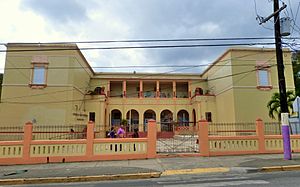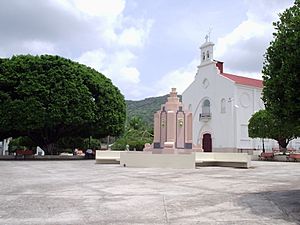Peñuelas, Puerto Rico facts for kids
Quick facts for kids
Peñuelas
Municipio Autónomo de Peñuelas
|
|||
|---|---|---|---|
|
Town and Municipality
|
|||

Daniel Webster School in Peñuelas
|
|||
|
|||
| Nicknames:
"La Capital del Güiro" ("The Güiro Capital"), "El Valle de los Flamboyanes" ("The Valley of the Poinciana Trees")
|
|||
| Anthem: "Así es mi pueblo" | |||

Map of Puerto Rico highlighting Peñuelas Municipality
|
|||
| Commonwealth | |||
| Founded | 1793 | ||
| Barrios | |||
| Area | |||
| • Total | 137.42 km2 (53.06 sq mi) | ||
| • Land | 114 km2 (44 sq mi) | ||
| • Water | 23.42 km2 (9.04 sq mi) | ||
| Population
(2020)
|
|||
| • Total | 20,399 | ||
| • Density | 148.443/km2 (384.465/sq mi) | ||
| • Ethnic groups (2000 Census) |
83.3% European 4.5% African 0.3% Arawak 0.1% Asian 0.1% Native Hawaiian/PI 9.4% Some other ethnicity 2.4% Two or more ethnicities |
||
| Demonym(s) | Peñolanos | ||
| Time zone | UTC−4 (AST) | ||
| ZIP Code |
00624
|
||
| Area code(s) | 787/939 | ||
| Major routes | |||
Peñuelas is a town and municipality in Puerto Rico located in the Peñuelas Valley on the southern coast of the island, south of Adjuntas, east of Guayanilla, west of Ponce and north of the Caribbean Sea. Peñuelas is spread over 12 barrios and Peñuelas Pueblo (the downtown area and the administrative center of the city). It is part of the Yauco Metropolitan Statistical Area. Peñuelas is known as "La Capital del Güiro" (The Güiro Capital) and "El Valle de los Flamboyanes" (The Valley of the Poinciana trees). In 2020, Peñuelas had a population of 20,399.
Contents
History
In 1754, a group of workers had settled over the bay of Tallaboa. Later gradually retreated deeper into the valley, heading towards the most fertile land which would then be part of the town of Peñuelas. For the year 1788, approximately 80 families inhabiting the valley, which focused mainly on agriculture and livestock. Peñuelas Township was founded August 25, 1793 by Diego de Alvarado. In 1874, the town had been developed and already had 9.206 inhabitants, according to a census of that year. The town already had four main roads, some streets, a brick church and the town hall, which also served as a prison, barracks and even cemetery and carnage. On March 1, 1902 the Legislative Assembly of Puerto Rico approved a law to consolidate certain municipal districts, so Peñuelas neighborhoods were attached to the town of Ponce. In 1905, the same Assembly repealed the law and it became again the municipality.
The first incident of the Puerto Rican Nationalist Party Revolts of the 1950s occurred during the early hours of October 29, 1950, in Peñuelas, when the insular police of that town surrounded the house of the mother of Melitón Muñiz Santos, the president of the Peñuelas Nationalist Party in the bario Macaná, under the pretext that he was storing weapons for the Nationalist Revolt. Without warning, the police fired upon the Nationalists in the house and a firefight between both factions ensued, which resulted on the death of two Nationalists and the wounding of six police officers. Nationalists Meliton Muñoz Santos, Roberto Jaume Rodriguez, Estanislao Lugo Santiago, Marcelino Turell, William Gutirrez and Marcelino Berrios were arrested and accused of participating in an ambush against the local insular police.
Geography
Rivers near Peñuelas include:
- Río Guayanés
- Río Macaná
- Río Tallaboa
Cityscape
Barrios
- Barreal
- Coto
- Cuevas
- Encarnación
- Jaguas
- Macaná
- Penuelas Pueblo
- Quebrada Ceiba
- Rucio
- Santo Domingo
- Tallaboa Alta
- Tallaboa Poniente
- Tallaboa Saliente
- Caracoles 1
- Caracoles 2
- Caracoles 3
- Belleza
- Alturas 1
- Alturas 2
- Las Quebradas
Communities
- Santo Domingo - (Santo Domingo)
- Tallaboa Alta - (Tallaboa Alta) / (Quebrada Ceiba)
- Tallaboa - (Encarnación)
Tourism
Landmarks and places of interest
- Charco La Soplaera (natural water pool)
- Convento Caverns
- Don Angel Pacheco Monument
- Guilarte Forest
- Unknown Soldier Monument
- Parque de Bombas
- "La Negra Cocola" 0-4-2T Baldwin Steam Locomotive on static display in town plaza
- Museum of Art and History
- Cancha Carlos Rentas Gallardo (Quebrada Ceiba)
Symbols
Flag
It has a rectangular bottom in canary yellow and stands for the sun, symbol of the physical life. In the center it has a purple or violet cross: symbol of Christianity and its ecclesiastical order; it represents the spiritual life. The cross purple extends to all the points of the yellow rectangle.
Coat of Arms
The adornment above the shield, a stone wall, represents the perpetuity. The cross represents Santo Cristo de la Salud that stopped the sea that flooded Peñuelas. The purple arm represents the priesthood and the town of Peñuelas. The canary yellow represents the sun. The blue and white symbolize the choppy sea and the regal ensign represents the faith in Christianity, "In God We Trust".
Culture
Literature
There are several poems that allude to the people of Peñuelas. Among them are the book, The Literature Peñuelas "Yagrumal" or "The Cultural History Peñolano Almanac, " which is classified into several volumes and contain poetry about the different neighborhoods and sections of the people of Peñuelas. Some of the poets who took the time to create works in relation to this southern town are E. Myriam Rodríguez Hernández, Manuel Díaz Rodríguez, Karina Arroyo, Carlos J. Velazquez Cruz (creator and editor of the journal Yagrumal), Elan Rafael Novoa, Miguel Feliciano Román, Silvio Echevarría Rodríguez, Rigoberto Ramirez Cruz, Marcos Ortiz Gelpi, Peter J. Ramos, Ramon Rivera (Bonye), among others.
Festivals and events
- Festival del Güiro (Güiro Festival) - May
- Fiestas Patronales (Patron Celebrations)- November
- Vuelta cyclista - Bicycle tour
- Festival Artesanal(craft festival)
Transportation
Peñuelas' public bus service ("la guagua") connects passengers to Ponce city (east) and Guayanilla (west).
There are 24 bridges in Peñuelas.
Prominent "Peñolanos"
- Erasmo Quiñones Rosado - (1948-2009) Puerto Rico Police Department Lieutenant Colonel
- Alfonso Santiago - Head of History at the Pontifical Catholic University of Puerto Rico.
- Lorenzo A. Balazquide - writer.
- Francisco Martinez - distinguished leader of the Popular Democratic Party in Peñuelas.
- Silvio Echevarría Rodríguez - writer, journalist, and labor leader.
- Manuel Diaz Rodriguez - educator, writer and independence activist
- Raquel Chalice - Amada Elementary School teacher Tallaboa.
- Germain Martinez-Ortiz - Chemical's petrochemical CORCO in 1970.
- Francisco A. Rodriguez Gonzalez- Distinguished International Professional Engineer-U.S. DOD, Research & Development, Merck Global Information Technology Research and Manufacturing Leader
- Candelario Miguel Angel Arce - House Representative (1949–1956), delegate to the Constituent Assembly (1948–1952), Mayor (1957–1968).
- González Gelcia Bigas - Distinguished educator and independence activist peñolana
- Luis E. Díaz Hernández - Former director of Puerto Rican Culture Institute and Director of the Department of History at the Pontifical Catholic University of Puerto Rico.
- Waldemar Purcell Gatell - Author of "Anthology of Storytellers Peñolanos
- Jose A. (Tony) Santos - Musician and writer. Creator of the Peñuelas anthem "That's my town. "
- Jorge M. Estrada Cruz - Pastor and writer. Author of Donde Esta El Dios De Elias? "Where is the God of Elijah?
Economy
Industry
Manufacturing, refinery.
Demographics
Puerto Rico was ceded by Spain in the aftermath of the Spanish–American War under the terms of the Treaty of Paris of 1898 and became a territory of the United States. In 1899, the United States conducted its first census of Puerto Rico finding that the population of Peñuelas was 12,129.
| Historical population | |||
|---|---|---|---|
| Census | Pop. | %± | |
| 1900 | 12,129 | — | |
| 1910 | 11,991 | −1.1% | |
| 1920 | 13,598 | 13.4% | |
| 1930 | 13,278 | −2.4% | |
| 1940 | 14,789 | 11.4% | |
| 1950 | 14,931 | 1.0% | |
| 1960 | 14,887 | −0.3% | |
| 1970 | 15,973 | 7.3% | |
| 1980 | 19,116 | 19.7% | |
| 1990 | 22,515 | 17.8% | |
| 2000 | 26,719 | 18.7% | |
| 2010 | 24,282 | −9.1% | |
| 2020 | 20,399 | −16.0% | |
| U.S. Decennial Census 1899 (shown as 1900) 1910-1930 1930-1950 1960-2000 2010 2020 |
|||
Sports
Peñuelas AA Amateur Baseball team is called Los Petroleros de Peñuelas (The Peñuelas' Oilers.) The origin of this name dates back to the days when Peñuelas was home to a major petro-chemical complex known as CORCO. Although CORCO closed operations in 1980, the name stuck throughout the years.
Also known as Luis "Tite" Arroyo's hometown, a baseball hero. Another hometown hero is Ivelisse Echevarria, who was inducted into the International Federation Softball Hall of Fame in 2003 and is considered by many to be the greatest softball pitcher born in Puerto Rico. Myrian "Betty" Segarra, who was inducted into the International Federation Softball Hall of Fame in 2003 and the best first base in the woman softball in Puerto Rico.
Education
6 Elementary schools, 4 Intermediate Schools, 1 High School
Images for kids
See also
 In Spanish: Peñuelas (Puerto Rico) para niños
In Spanish: Peñuelas (Puerto Rico) para niños





